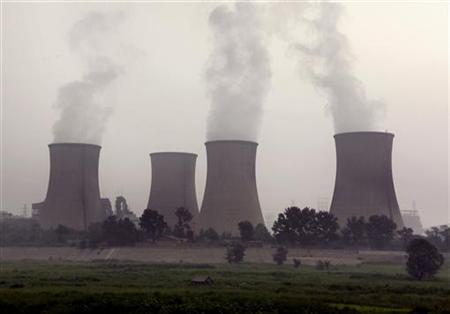World Must Plan For Climate Emergency: Report
Country: UK
Author: Gerard Wynn

A small house can be seen in front of a
coal-burning power station located on the outskirts of Beijing
August 17, 2009.
Photo: David Gray
LONDON - Humans may have to reset the Earth's natural thermostat and develop new technologies like reflecting sunlight back into space if climate talks fail, Britain's top science academy said on Tuesday.
So-called geoengineering was not a quick fix but may be needed to head off planetary catastrophe and so deserved more research as an insurance policy, the Royal Society said in a report, "Geoengineering the climate."
Such technologies were not an alternative to cutting emissions, however, the report stressed.
Political efforts to curb greenhouse gases are in the spotlight three months before a U.N-led meeting meant to clinch a new climate treaty to replace the Kyoto Protocol.
"Nothing should divert us from the priority of reducing global carbon dioxide emissions and ensuring that the December meeting in Copenhagen does lead to real progress," said Royal Society President Martin Rees.
"But if such reductions achieve too little too late there will be surely pressure to contemplate a plan B," he told an audience at the launch of the report in central London.
Growing interest in geoengineering was partly motivated by a "false hope of a quick fix," Rees said, and Greenpeace's Doug Parr said that it would be seized upon by polluters.
Britain's chief scientific adviser John Beddington supported more research, however. "They are part of the solution," he said of the technology, and painted a bleak picture for the planet.
"There's an enormous 'if' whether there'll be comprehensive action agreed in Copenhagen, whether it's going to be enough. There are also going to be (climate) emergencies and surprises," he said, referring to the "devastating" risk of more acidic oceans as a result of carbon emissions.
MIRRORS
Geoengineering technologies can be divided between those that remove the greenhouse gas carbon dioxide (CO2) from the atmosphere and those which reflect sunlight back into space.
Such technologies are now limited to the laboratory and the Royal Society report called for a 10-year, 100 million pound ($163.2 million) British research program, a 10-fold increase.
People have spewed carbon dioxide (CO2) into the air for thousands of years from burning forests to clear farmland and more recently burn fossil fuels in the industrial revolution.
Reversing that trend of emissions poses an enormous challenge, leading to a growing enquiry into geoengineering.
"Do we need it? I think there is a significant risk that we shall make insufficient progress with emissions reductions and that some support for conventional emissions reductions may be needed," said co-author, James Wilsdon.
The report supported steps to remove CO2 from the air above others, because they addressed the underlying problem of too many heat-trapping gases, and so were more predictable and would fight not only climate change but also acidifying oceans.
In the event of an emergency where the Earth suddenly pitched into a different, hotter climate, however, the world may need to reflect back some sunlight, the report said, for example by shooting highly reflective aerosols into the atmosphere.
That would introduce a new influence on the Earth's climate besides greenhouse gases and so was less predictable, especially if not applied across the whole atmosphere.
"You could actually seriously and adversely impact one of the most critical weather patterns on the planet," said lead author John Shepherd, referring to disruption of the monsoon.
© Thomson Reuters 2009 All rights reserved
